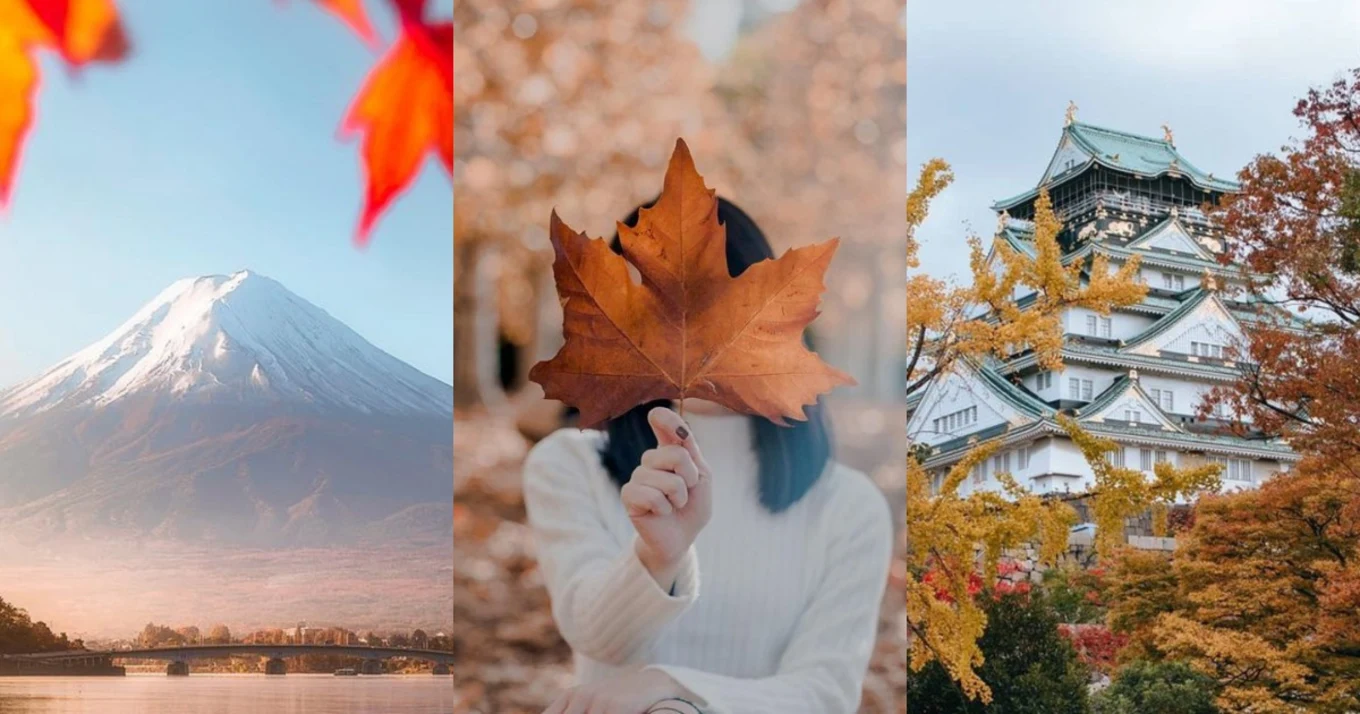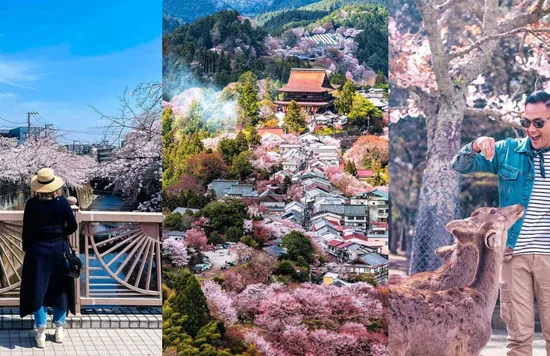Have you been dreaming of visiting Japan during cherry blossom season but haven’t made it there yet? Well, you might want to consider the other end of the spectrum— maple leaf season!
Yes, Japan has maple leaves, and the “autumn colours” take place from around late November to early December, and instead of being bathed in pink like during the cherry blossom season, the streets will glow a golden hue as the temperature drops and inches towards winter. The types of trees to look out for during autumn colours are the Maple and Gingko trees, which go from green to red and yellowy-orange respectively. So, grab a pumpkin-spiced latte and wrap that chunky scarf around your neck—you’ve got some awe-inspiring photos to take!
Since you’re already in Japan, you might still want to see the lovely cherry blossoms. You can still do so! Head over to these destinations to see the cherry blossoms even if they’re out of season.
1. What do maple leaves symbolise in Japan?
You don’t need to leave Tokyo to see autumn colours. Credit to @eva_phan on Instagram
Aside from being natural wonders, Japanese maple trees and maple leaves are actually quite meaningful to the country and the culture. The beautiful burnt orange trees are often referenced in Japanese art, poetry, and literature. Throughout the country and across the world, Japanese maple trees are symbols of elegance, beauty, and grace. The turning of the leaves to its warm colours are actually an anticipated event by tourists and locals every year as the trees, the colours, and deer symbolise the arrival of autumn.
2. Where are the prettiest spots to see maple leaves?
Ginkgo Avenue / Icho Namiki
Take the train to Aoyama-Itchome Subway Station and walk just one block until you get to Meiji Jingu Gaien Park. This park is home to Icho Namiki, where giant trees line the avenue during the autumn colours season, looking like golden temples built from leaves. Here, you can relax at a nearby café, stroll around the park, and fulfill your childhood fantasies of crunching around in the fallen foliage. Maple leaf angel, anyone?
Showa Memorial Park
Showa Memorial Park is worth a visit whether or not you’re travelling to experience Japan’s autumn season. During the rest of the year, this huge area is a beautifully maintained space full of colour and life. In autumn, those shades shift to warm hues and turn the park into a gold-dipped wonderland. The best autumn coloured ginkgo trees can be found at the main entrance, while maples are dotted around the park for easy spotting.
Imperial East Garden
Set in the heart of Tokyo, just around the Marunouchi district and within walking distance of JR Tokyo station, you can find the Imperial Castle. Inside the grounds, you will come across the Imperial East Garden, and when the trees here turn gold during autumn you’ll get the full magic castle experience. The Imperial East Garden is the most perfect destination if you are looking for a pleasant place to escape the bustling pace of Tokyo without having to leave the city.
Koishikawa Korakuen
With this garden being created more than 400 years ago, it’s safe to say that a few people would have enjoyed Japan’s autumn colours at Koishikawa Korakuen before you. This glorious space is straight out of a picture book and features a mix of both traditional Chinese and Japanese landscaping, complete with three ponds and sweet little arched bridges. The Tokyo Dome juxtaposes against the trees in the background in a very modern way, tying the old and new worlds together. You can spot reddened leaves throughout the park and handy stone-paved walkways make it easy to stroll the day away around the grounds.
Access to Koishikawa is available via JR Suidobashi Station, Iidabashi Station or Korakuen Station.
Rikugien
One of the best autumn viewing points in all of Tokyo, Rikugien, is more than 300 years old and considered to be one of Japan’s most beautiful traditional gardens. For a quintessentially Japanese experience, you won’t find a better location—especially not in the middle of Tokyo—and you certainly won’t find a more unique living backdrop for all your insta-worthy photos. Rikugien features many stunning spots to grab the perfect shot and once you’re done you can relax in one of the quaint tea houses while you soak in the serenity.
You can visit Rikugien all year ‘round, but if you’re looking to experience Japan’s autumn season to the fullest, the best spots for you to see the entire scope of the red and yellow trees is from near the Tsutsuji no Chaya teahouse or the Fujishirotoge viewpoint. To get here, take the JR Yamanote Line or Namboku Subway to Komagome Station and head out the southern exit.
Mount Fuji
A trip out toMount Fuji and its surroundings will offer a different perspective of autumn colours, and is a very doable day trip from Tokyo. With more space, you can take in the full range of the landscape as well as the vibrant array of colours spanning from beige through to a flaming red.
Key viewing points include Lake Kawaguchiko and Lake Yamanaka, where the contrast of the leaves against the icy blue backdrop of the lakes and the mountain will make the scene even more surreal. Remember to bundle up well if you plan on making the trip to Mount Fuji—it will be significantly colder than Tokyo at this time of the year!
If you’re able to explore Japan’s autumn outside of Tokyo, Kyoto, Hokkaido, and Osaka all offer incredible spots to capture the fall foliage as detailed in this guide.
3. How cold does it get in Tokyo during autumn?
Although the weather in early autumn can feel like a regular summer’s day, the leaves begin to turn later in the season. This means that if you are travelling to Tokyo strictly to experience Japan’s autumn, you should expect daytime temperatures in the mid-to-late teens with single digits in the mornings and nights. Over the course of the day, the temperature could fluctuate from anywhere between 7 degrees Celsius right up to 19 degrees Celsius. In early December, however, things can get a little chilly! You can expect to be in temperatures of around 5 degrees Celsius in the morning and the evening, with little improvement during the day at an average of 12 degrees. With that said, it’s time to air out the knitwear.
4. What should I pack?
Most of it depends on the types of ‘fits you want to show off in your Insta pics, but if you want to know if it’s coat season or if a light jacket will do, the answer is layer, layer, layer. While the early morning and nights are cold, autumn days in Tokyo can be pleasantly warm. Although winter in Japan can bring freezing temperatures, during Japan’s autumn, you can get away with a thinner layers, but your best bet is to be prepared for a wide range of weather.
Tip: You’ll also want to ensure you’ve packed a comfy and sturdy pair of walking shoes since most of the best viewing points for these trees are within parks and/or walking distance from train stations.
5. What else should I look out for?
It seems like not a single special event can go by without Kit Kat Japan releasing a limited-edition flavour to mark the occasion. Autumn is no different, and some of the unique treats they’ve sold in the past include chestnut and sweet potato flavours. What will they think of next and will you dare to give it a whirl?
In a similar style, Starbucks loves an opportunity to theme their drinks and merchandise to match the latest festivities. Keep an eye out for mugs and cups featuring red and yellow leaves printed alongside iconic Japanese landmarks like Mount Fuji—a cute and useful keepsake to remember your trip by.
Other seasonal souvenirs you might spot on your travels include beautiful warm-toned stationery, sake bottles and tenugui (tea towels) printed with momiji, maple leaf stickers or even a Japanese maple bonsai!
6. How can I get warm after a day spent outside?
There’s no better way to get some warmth back in your bones than by relaxing at a hot spring. For city-dwellers, there’s an option right in the centre of town, which means you can have the feel of an authentic onsen without venturing out to a regional area. If it’s a massage or beauty treatment you’re after, you will find those at Oedo Onsen Monogatari too.
Tokyo in autumn can be more than just a holiday. It can be a romantic way to reconnect with nature and experience a side of Japan that isn’t so well-known. If you can brave the slightly colder weather, you will be rewarded with an abundance of beauty via the autumn colours.
Explore some more of Japan’s breathtaking sightseeing spots during autumn.
Updated by: Gabby Mendoza































